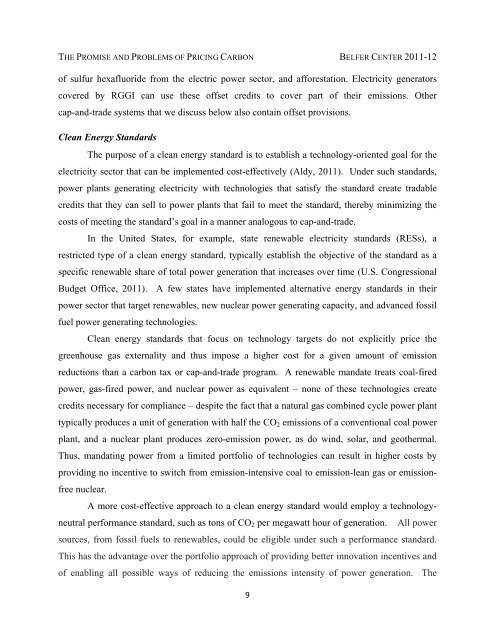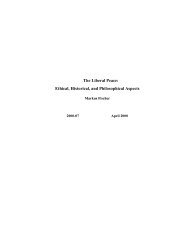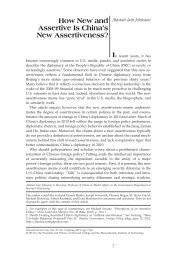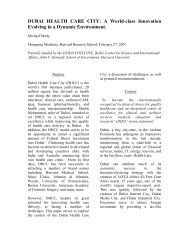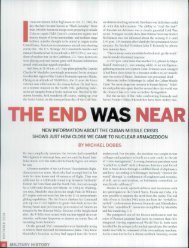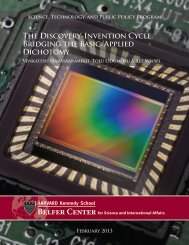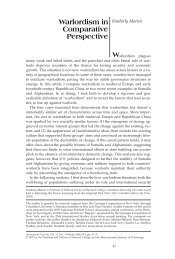The Promise and Problems of Pricing Carbon: - Belfer Center for ...
The Promise and Problems of Pricing Carbon: - Belfer Center for ...
The Promise and Problems of Pricing Carbon: - Belfer Center for ...
Create successful ePaper yourself
Turn your PDF publications into a flip-book with our unique Google optimized e-Paper software.
THE PROMISE AND PROBLEMS OF PRICING CARBON BELFER CENTER 2011-12<br />
<strong>of</strong> sulfur hexafluoride from the electric power sector, <strong>and</strong> af<strong>for</strong>estation. Electricity generators<br />
covered by RGGI can use these <strong>of</strong>fset credits to cover part <strong>of</strong> their emissions. Other<br />
cap-<strong>and</strong>-trade systems that we discuss below also contain <strong>of</strong>fset provisions.<br />
Clean Energy St<strong>and</strong>ards<br />
<strong>The</strong> purpose <strong>of</strong> a clean energy st<strong>and</strong>ard is to establish a technology-oriented goal <strong>for</strong> the<br />
electricity sector that can be implemented cost-effectively (Aldy, 2011). Under such st<strong>and</strong>ards,<br />
power plants generating electricity with technologies that satisfy the st<strong>and</strong>ard create tradable<br />
credits that they can sell to power plants that fail to meet the st<strong>and</strong>ard, thereby minimizing the<br />
costs <strong>of</strong> meeting the st<strong>and</strong>ard’s goal in a manner analogous to cap-<strong>and</strong>-trade.<br />
In the United States, <strong>for</strong> example, state renewable electricity st<strong>and</strong>ards (RESs), a<br />
restricted type <strong>of</strong> a clean energy st<strong>and</strong>ard, typically establish the objective <strong>of</strong> the st<strong>and</strong>ard as a<br />
specific renewable share <strong>of</strong> total power generation that increases over time (U.S. Congressional<br />
Budget Office, 2011). A few states have implemented alternative energy st<strong>and</strong>ards in their<br />
power sector that target renewables, new nuclear power generating capacity, <strong>and</strong> advanced fossil<br />
fuel power generating technologies.<br />
Clean energy st<strong>and</strong>ards that focus on technology targets do not explicitly price the<br />
greenhouse gas externality <strong>and</strong> thus impose a higher cost <strong>for</strong> a given amount <strong>of</strong> emission<br />
reductions than a carbon tax or cap-<strong>and</strong>-trade program. A renewable m<strong>and</strong>ate treats coal-fired<br />
power, gas-fired power, <strong>and</strong> nuclear power as equivalent – none <strong>of</strong> these technologies create<br />
credits necessary <strong>for</strong> compliance – despite the fact that a natural gas combined cycle power plant<br />
typically produces a unit <strong>of</strong> generation with half the CO2 emissions <strong>of</strong> a conventional coal power<br />
plant, <strong>and</strong> a nuclear plant produces zero-emission power, as do wind, solar, <strong>and</strong> geothermal.<br />
Thus, m<strong>and</strong>ating power from a limited portfolio <strong>of</strong> technologies can result in higher costs by<br />
providing no incentive to switch from emission-intensive coal to emission-lean gas or emissionfree<br />
nuclear.<br />
A more cost-effective approach to a clean energy st<strong>and</strong>ard would employ a technologyneutral<br />
per<strong>for</strong>mance st<strong>and</strong>ard, such as tons <strong>of</strong> CO2 per megawatt hour <strong>of</strong> generation. All power<br />
sources, from fossil fuels to renewables, could be eligible under such a per<strong>for</strong>mance st<strong>and</strong>ard.<br />
This has the advantage over the portfolio approach <strong>of</strong> providing better innovation incentives <strong>and</strong><br />
<strong>of</strong> enabling all possible ways <strong>of</strong> reducing the emissions intensity <strong>of</strong> power generation. <strong>The</strong><br />
9


